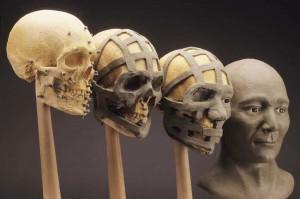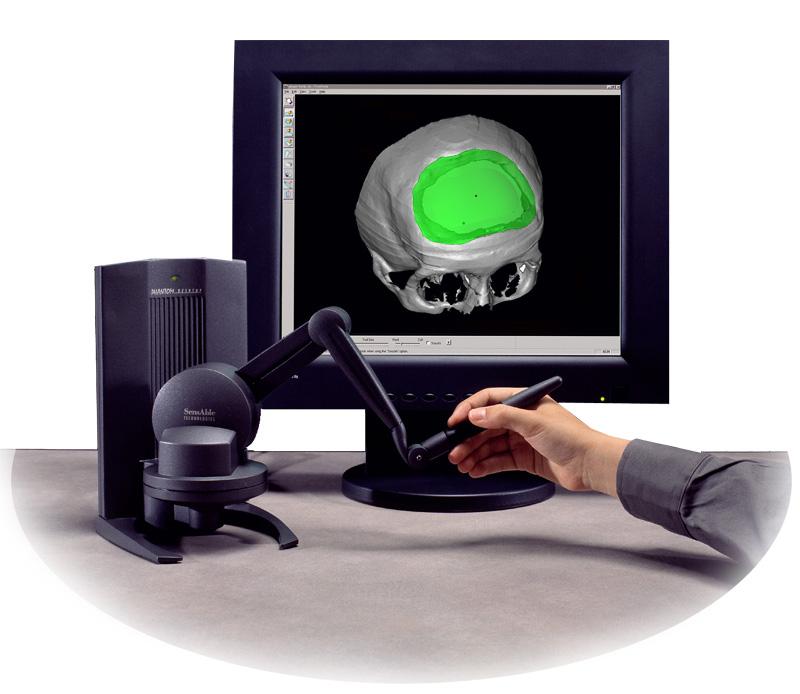3D printing is now proving extremely useful in the field of forensic facial reconstruction, a method of identifying skeletal remains. The process consists of recreating the face of a person with only the skull as a reference. An artist schooled in anatomy, anthropology, osteology (the study of the functio n and structure of the skeleton), and forensic science gradually builds up the face from the surface of the skull, adding clay like layers of tissue — muscles, cartilage, tendons, and so on until the skin and facial features are in a sense restored.
n and structure of the skeleton), and forensic science gradually builds up the face from the surface of the skull, adding clay like layers of tissue — muscles, cartilage, tendons, and so on until the skin and facial features are in a sense restored.
This practice is used in situations where human remains are found in order to attempt to identify the person and to determine whether a crime has been committed. It is also used by anthropologists and archaeologists when remains of ancient humans and homonids are discovered.
A major problem with the current practice of forensic facial reconstruction is that the skull must be used and can, in the process, potentially be damaged. Even though the layers of clay are removed after the reconstruction has been completed and the finished work photographed, it isn’t an ideal scenario. 3D modeling and printing provides an excellent alternative to using the skull and one Tampa, Florida company, Engineering and Manufacturing Services, Inc. (EMS), has developed a system of forensic facial reconstruction that eliminates the need to use the skull.
though the layers of clay are removed after the reconstruction has been completed and the finished work photographed, it isn’t an ideal scenario. 3D modeling and printing provides an excellent alternative to using the skull and one Tampa, Florida company, Engineering and Manufacturing Services, Inc. (EMS), has developed a system of forensic facial reconstruction that eliminates the need to use the skull.
EMS assisted the Hillsborough County (Florida) Coroner’s Office in the identification of a person whose remains had been discovered. They used a Z Scanner Z800 (manufactured by Z Corp) to create a 3D scan of the skull. The scan was given to SensAble Technologies (now part of Geomagic), which has a feature called “Clay Tools,” that enables technicians to imitate the real-life building up of clay on the surface of the skull that happens with traditional forensic facial reconstruction. The program has a feature that creates virtual tissue depth markers, allowing the 3D artist to reconstruct features on the scanned skull layer by layer.
Once the reconstruction process if completed, EMS produced a full color 3D print of the artist’s rendering using a Z650 3D printer, also made by Z Corp. The printer allows for a lifesize replica to be produced, a model that can be retained for evidence or display, depending upon the circumstances. Significantly, with forensic facial reconstruction, it is standard practice to have several artists create reconstructions, particularly focusing on facial features, which are considered to be difficult to discern solely from the shape of skull and layers of tissue. This is why the results of forensic facial reconstruction are not considered admissable in court as evidence, because the facial features are truly subject to interpretation. Regardless, the obvious applicability of 3D technology in this field is an exciting step forward. Let’s hear your thoughts on this new approach in the 3D Printed Forensics forum thread on 3DPB.com.
Subscribe to Our Email Newsletter
Stay up-to-date on all the latest news from the 3D printing industry and receive information and offers from third party vendors.
You May Also Like
3D Printing Financials: Fathom Struggles in Financial Quicksand During Critical Transition
Facing a year of key transitions and financial pressures, Fathom (Nasdaq: FTHM) has filed its annual report for 2023 with the U.S. Securities and Exchange Commission (SEC). The document outlines...
Latest Earnings Overview for Australian 3D Printing Firms Titomic and AML3D
Australian 3D printing manufacturing firms Titomic (ASX: TTT) and AML3D (ASX: AL3) reported their financial results for the period from July to December 2023, marking the first half of their...
3D Printing Webinar and Event Roundup: April 7, 2024
Webinars and events in the 3D printing industry are picking back up this week! Sea-Air-Space is coming to Maryland, and SAE International is sponsoring a 3D Systems webinar about 3D...
3D Printing Financials: Unpacking Farsoon and BLT’s 2023 Performance
In the Chinese 3D printing industry, two companies, Farsoon (SHA: 688433) and Bright Laser Technologies, or BLT (SHA: 688333), have recently unveiled their full-year earnings for 2023. Farsoon reported increases...

































